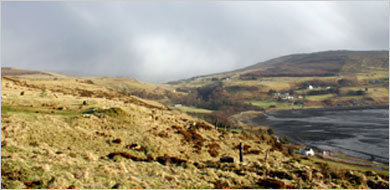The HITRANS Area
The HITRANS area is unique within the UK. Its general remoteness from major population centres is one of its defining features. However, it is also diverse, containing a mixture of islands, remote mainland, rural and urban areas.
|
|
The area includes the fast growing city of Inverness and other major settlements such as Elgin and Oban, while also remote islands with populations of under 100 people.
The main transport issues are different for different communities. Parts of the Inner Moray Firth area face growing road congestion, while for islands in Argyll & Bute the main issue may be the cost and timetabling of ferry services.
The Facts
The area is large, accounting for around 50% of Scotland's land mass. It includes long, indented coastlines as well as mountainous areas. It also has many inhabited islands. These physical features act as barriers to the movement of people and goods. Routes can be slow and/or circuitous, increasing the time and cost of travel.
Despite its size, the HITRANS area is home to less than 10% of Scotland's population. The small scale of the local market means that many businesses have a strong outward focus, selling goods and services outside the area. This means that transport links with other parts of Scotland and beyond are as important as those within the area itself.

|
|
The wide dispersal of settlements, and sparsity of population and businesses, characterise much of the area. They create a number of challenges for the transport network, especially:
- Cost effective delivery of public transport. Limited frequency of bus and train services means that for many car ownership is a necessity rather than an option. The cost of road fuel is a key issue for many communities.
- Long distances involved in trip making, adding time and cost to many journeys.
Population
Some parts of our area are growing strongly, with rising population levels. Others face challenges in terms of sustaining economic activity and reversing population decline. However, as a whole, the area is less prosperous than the Scottish average. There is a need to increase income for businesses and residents in order to close the gap with the rest of the country. It is generally recognised that improving the transport network will play an important part in achieving this objective.
The Environment
The natural environment is important in attracting both visitors and residents to our area. It is also a factor in the quality and marketing of some businesses' products. The environmental resource of the area-wind, wave and tidal-presents a major economic opportunity through renewable energy. The challenge is to continue to develop our transport network without compromising our pristine environment.
|